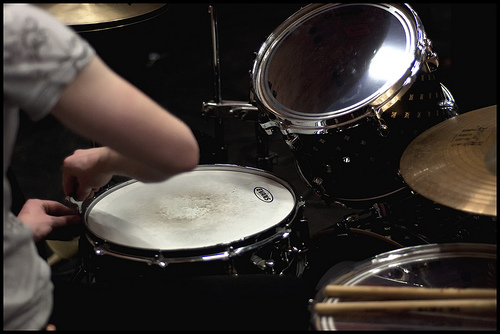A tension gauge to measure the tautness of the drum head at various points is a much more accurate means of achieving cohesion between different drums, whether you’re tuning a kit for a rock show or the percussion section in a drum corps or marching band. While digital drum tuners give you more options, analog models are simpler to use and easier to take along for quick check-ups on the road, and either can be an excellent tool for getting the best possible sound out of your equipment.
Below are our suggestions for the 4 best drum tuners on the market:
Pearl TB001 Tune-Bot Drum Tuner
This little clip-on digital drum tuner can drastically speed up your tuning process, especially if you have a lot of drums to tune. It takes and stores readings from both the center of the drum head and the edge near the lugs to get an accurate sense of the drum head’s intonation and tension. The overtone filtering increases the accuracy of readings and can be helpful in compensating for ear fatigue. The Tune-Bot also gives you 80 save slots for specific drum pitches and tensions, so you can find your drum’s sweet spot every time, giving you more freedom to experiment without losing your ideal sound.
DrumDial Digital Drum Tuner
The DrumDial Digital uses a unique tympanic pressure tuning system that lets you get an accurate reading without needing to hit the drumheads, making it an excellent tool for a band director or shop owner who needs to tune a large number of drums to the same pitch. The DrumDial Digital is especially helpful in tuning snares, which can be trickier to tune than a tom or kick drum. This digital model can also save tensions in its memory, allowing you to easily keep track of your ideal drum tensions across multiple heads and maintain a consistent sound without having to spend a lot of time tuning. This should be on anyone’s list of the best drum tuner.
TAMA TW100 Tension Watch Drum Tuner
If you’re looking for an analog rather than a digital tuner, check out the TAMA Tension Watch. It measures the tension of the actual drum head, rather than the tuning rod, giving you an extremely accurate reading on a large and easy to read meter. The heavy-duty base and durable case make it a great tool for professional drummers to take along to gigs and recording sessions for quick tune-ups and tone checks—and since it’s fully analog, it’s ready to go at all times. For newer drummers, the Tension Watch is also an excellent aid in training your ears and hands to get the best sound out of your drums.
DrumDial Drum Tuner
The most affordable tuner on this list, the analog version of the DrumDial is an excellent tool for amateur and experienced drummers alike. The DrumDial is a similar tool to the Tension Watch; comparing the two head-to-head, the DrumDial is easier to use, though the Tension Watch is a bit more sensitive. Like the Tension Watch, the DrumDial is great to throw in with your drum gear to take along for quick tune-ups on gigs, and can be a fabulous tool for learning how to tune. This is likely the best drum tuner for the money.
Drum Tuners: Other Equipment
To perform the actual tuning process on your drums, you’ll need a tuning key (see a bunch here). This is used to increase or lower the tension on the tension rods around the drumhead, thereby raising or lowering the pitch produced on striking. Most tension rods are square-headed, though different manufacturers and drum styles may have slightly different head sizes on their rods so you should make sure that whichever one you buy fits the tension rods on your particular drums. Drum keys are relatively inexpensive, costing ten dollars or less at music stores or online vendors.
Drum Tuner: The Tuning Process
Most professional drummers will tell you that the best drum tuner is your own ear when it comes to achieving the perfect tuning, but the sustain and overtones of snare drums, especially, can make it very difficult to hear the actual pitches of your drum heads if you’re a relatively young player. Experienced musicians who aren’t percussionists can also find tuning a drum head difficult since the mechanics of the process are so different from the tuning of mainly melodic instruments.
Generally speaking, the top head (or batter head, for kick drums) should be thicker, while the bottom or resonant head (or front head, for kick drums) should be thinner, and is typically clear. The tension of the top or batter head will change more often because of the impact of sticks or beaters and will likely need to be adjusted more frequently than the bottom. If you’re installing a new head on a drum, you’ll need to seat it before playing on it. To do this, stretch the head uniformly—a half-turn of the drum key at a time the whole way around the rim—past the point that you’ll likely play it. The idea is to stretch the head and let it conform to the edges, but don’t stretch it too far or you run the risk of breaking the head.
Once the head is seated, you need to clear it. This is arguably the most difficult stage of tuning a drum head. Start by adjusting the lugs until the pitches match the entire way around. This will stabilize the overtones and make it easier to hear the tones as you’re going. If you’re not sure how to achieve this, try loosening all the lugs once the head has been seated. Finger-tighten them as far as you can then give each lug a half turn with the drum key in a crossing pattern. Tap the head near each lug periodically as you go. If it seems to low, tighten that rod more; if it’s too high, loosen it slightly. Working in small increments allows you to get the correct tone throughout the drum without damaging the head. Good luck!







